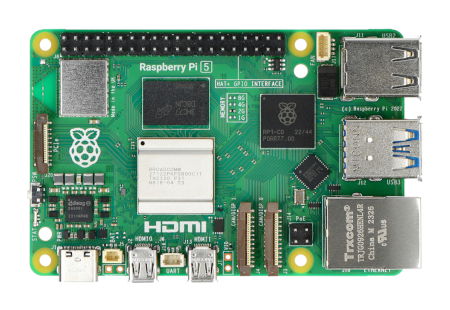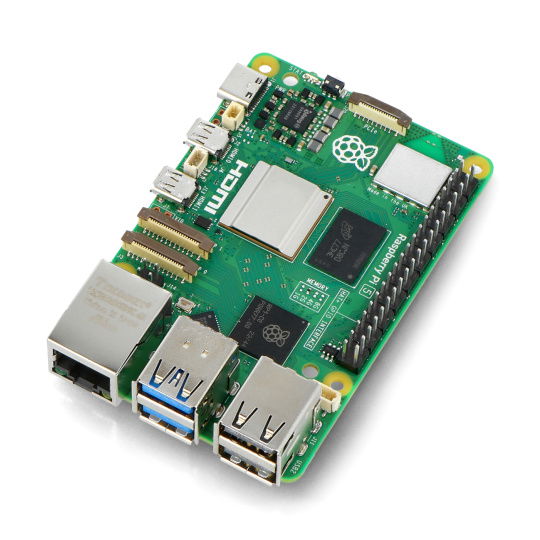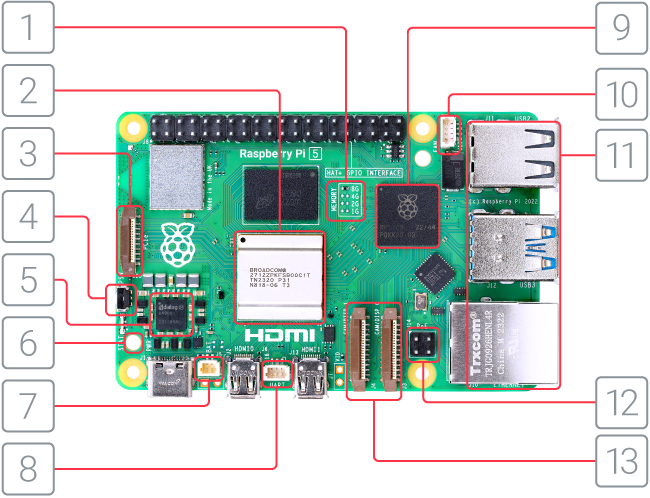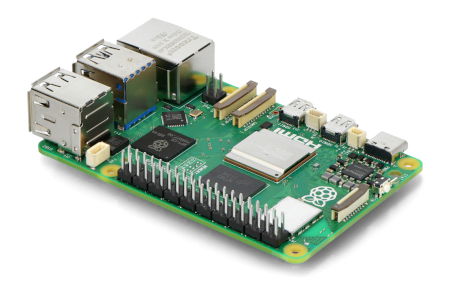Product description: Raspberry Pi 5 2GB
Raspberry Pi 5 in the version equipped with 2 GB of RAM LPDDR4X-4267 . The new quad-core Broadcom BCM2712 ARM Cortex-A76 64-bit processor offers a clock speed of 2.4 GHz . The fifth version of the popular raspberry has two microHDMI connectors, two USB 3.0 connectors and two connectors USB 2.0, USB C power connector. The Raspberry Pi 5 also offers two 4-lane MIPI DSI/CSI camera/display connectors , a PCI Express 2.0 connector, a fan connector, a UART and RTC battery connector, and a power button . The board is also equipped with dual-band 2.4 GHz and 5 GHz WiFi, Bluetooth 5 BLE and a 1000 Mbps Ethernet port with PoE power supply option (PoE+ HAT required). The board still has a 40-pin GPIO connector (2x20 pin, 2.54 mm pitch) and a microSD memory card connector with an operating system. In addition to the standard mounting holes, you can also find holes dedicated to mounting the official radiator with a fan.
Layout and description of components on the Raspberry Pi 5 board
- Model designation
- Broadcom BCM2712 processor
- PCI Express 2.0 interface
- ON/OFF button
- Power management system
- Active Cooling/Radiator Mounting Holes
- RTC Battery Connector
- UART connector
- Raspberry Pi RP1 I/O controller
- Fan connector
- Ethernet and USB ports (reversed from Raspberry Pi 4)
- PoE HAT connector
- 2x 4-lane MIPI DSI/CSI connectors
Changes in Raspberry Pi 5
| Characteristic | Description |
|---|---|
| Several versions | Raspberry Pi 5 is available in several versions with different amounts of RAM: 1 GB, 2 GB, 4 GB, 8 GB. |
| BCM2712 Processor | The Broadcom BMC2712 Quad-Core ARM Cortex-A76 64-bit chip clocked at 2.4 GHz is 60% faster than its predecessor. |
| PCIe 2.0 connector | The fifth version of Raspberry Pi is equipped with a fast PCI Express 2.0 connector, allowing you to connect peripherals with fast data transfer. |
| RTC Battery Connector | A dedicated connector allows you to connect a real-time clock (RTC) battery to maintain the current date and time. |
| UART connector | There is a UART connector on the board to which you can connect a debugger. |
| Two CSI/DSI connectors | Raspberry Pi 5 is equipped with two 4-lane MIPI CSI / DSI connectors in mini 22-pin format in 0.5 mm pitch, to which you can connect a camera and a display or two cameras / two displays. |
| ON/OFF button | The Raspberry Pi minicomputer can now be turned on/off using the power button. The button can also be used to wake the Raspberry Pi from deep sleep mode. A long press of the button cuts off the power from the minicomputer. |
| Raspberry Pi RP1 system | The RP1 was designed specifically by the Raspberry Pi Foundation to handle I/O interfaces, offloading the minicomputer's main processor, making the Raspberry Pi 5 significantly more powerful than its older predecessors. |
| Layout of connectors | The board outline remains the same as in previous versions, but the layout of the interfaces has changed. |
Video and audio on Raspberry Pi 5
The fifth version of the Raspberry Pi is equipped with two microHDMI connectors , through which both image and sound can be transmitted even in 4K resolution and 60 fps. Raspberry Pi 5 has two 4-line MIPI CSI / DSI sockets , to which you can connect two screens with the ability to display images in 4K resolution or two cameras. The Raspberry is equipped with a VideoCore VII GPU graphics card clocked at 800 MHz. The CSI / DSI connectors have 22 lines in a 0.5 mm pitch , so in order to continue using the existing accessories, it is necessary to use an adapter.
Raspberry Pi OS operating system
Raspberry Pi 5 is equipped with a microSD memory card slot (with support for SDR104 high-speed mode), from which the Raspberry Pi OS system is launched. The system can also be launched from the USB port of the minicomputer. In our offer you will also find memory cards with the appropriate operating system installed, ready to work immediately after unpacking. Raspberry Pi 5 works with the Raspberry Pi OS system in the Bookworm version and newer.
Communication in Raspberry Pi 5
The fifth version of the Raspberry Pi still has the popular interfaces known from standard PC computers. The most important of them are:
- 2 microHDMI ports with the ability to connect two screens simultaneously and display images in 4K resolution.
- WiFi module - dual-band 2.4 GHz and 5 GHz 802.11b/g/n/ac.
- Bluetooth LE module - popular Bluetooth Low Energy (LE) 5.0 wireless connection.
- 4 USB ports - Raspberry Pi 5 has 2 USB 2.0 ports and 2 USB 3.0 ports supporting 5 Gb/s operation simultaneously, to which you can connect peripheral devices.
- Ethernet port - enables a wired connection to the Internet at speeds up to 1000 Mb/s. The Ethernet port can also be used to power the Raspberry Pi (PoE+ HAT required).
- GPIO - 40-pin general purpose input/output, which includes interfaces such as I2C, SPI and UART. Used for LEDs, buttons, motor drivers and much more.
 The fifth version of the Raspberry Pi 5 is equipped with a power button, RTC battery connector, PCI-e and UART.
The fifth version of the Raspberry Pi 5 is equipped with a power button, RTC battery connector, PCI-e and UART.Raspberry Pi 5 Power Supply
The Raspberry Pi 5 minicomputer is equipped with a USB Type-C port, used to power the unit. The fifth version of the popular Raspberry Pi requires a power supply with a supply voltage of 5 V and a current capacity of at least 5 A. Our offer includes original power supplies and branded replacements that work with Raspberry Pi. The maximum current capacity of USB ports is 600 mA by default, while when a USB C power supply with the Power Delivery function is detected, the limit will be automatically increased to 1.6 A.
Raspberry Pi 3B+, 4B and 5 Specifications and Comparison
 |
 |
 |
|
| Model | Raspberry Pi 3 model B+ | Raspberry Pi 4 model B | Raspberry Pi 5 |
| Issue | 3 - 2018 | 6 - 2019 | 9 - 2023 |
| Chipset Processor | Broadcom BCM2837B0 64-bit | Broadcom BCM2711 64-bit | Broadcom BCM2712 64-bit |
| Core | Quad Core ARM Cortex-A53 |
Quad Core ARM Cortex-A72 |
Quad Core ARM Cortex-A76 |
| Operating systems | Raspberry Pi OS Windows 10 lT |
Raspberry Pi OS | Raspberry Pi OS |
| Clocking | 1.4GHz | 1.5GHz | 2.4GHz |
| Architecture | ARMv8-A | ARMv8-A | ARMv8-A |
| RAM memory | 1GB LPDDR2 @ 900MHz | Several versions
|
Several versions
|
| Memory | microSD card | microSD card | microSD card |
| GPIO socket | 40-pin connector (2x20 pin) 2.54 mm raster |
40-pin connector (2x20 pin) 2.54 mm raster |
40-pin connector (2x20 pin) 2.54 mm raster |
| Power supply |
|
|
|
| Dimensions of the plate | 85 x 56 x 17mm | 85 x 56 x 17mm | 85 x 56 x 17mm |
| USB interface | 4x USB 2.0 - type A socket | 2x USB 2.0 - type A socket 2x USB 3.0 - type A socket |
2x USB 2.0 - type A socket 2x USB 3.0 - type A socket |
| Network interface | 300 Mbps Ethernet port | 100/1000 Mbps Ethernet port | 100/1000 Mbps Ethernet port |
| Wi-Fi interface | Dual Band 2.4GHz and 5GHz 802.11b/g/n/ac |
Dual Band 2.4GHz and 5GHz 802.11b/g/n/ac |
Dual Band 2.4GHz and 5GHz 802.11b/g/n/ac |
| Bluetooth | Low Energy, BLE 4.2 | Low Energy, BLE 5 | Low Energy, BLE 5 |
| Camera | CSI nest | CSI nest | 2x 4-lane MIPI CSI/DSI socket |
| Touchscreen display | DSI socket | DSI socket | 2x 4-lane MIPI CSI/DSI socket |
| Video | HDMI HD 1080px / 30fps H.264 1080p30 OpenGLES 1.1, 2.0 |
2 x microHDMI H.265 4K 60fps H.264 1080p 30fps OpenGL 1.1, 2.0, 3.0 |
2 x microHDMI H.265 4K 60fps H.264 1080p 30fps OpenGL 1.1, 2.0, 3.0 |
| Communication | UART, SPI, I2C, GPIO | UART, SPI, I2C, GPIO | UART, SPI, I2C, GPIO |






















































































































































































































































































































































































